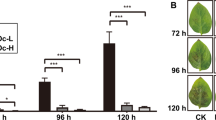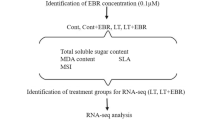Abstract
Green leaf volatiles (GLVs) are initially formed in the form of aldehydes, and then converted to alcohol and ester forms by the enzymes from plants. However, it remains unclear whether and how plant microbes work with aldehyde GLVs, especially under stressed conditions. Here, transcriptional response of cold-pretreated Pantoea agglomerans KSC03, an endophyte from Astragalus membranaceus var. mongholicus roots to E-2-hexenal was investigated and verified by real-time PCR and GC–MS after the time length of cold pretreatment was optimized. The results revealed that a 12-h cold stress was the most effective for KSC03 to trigger positive response to E-2-hexenal as far as the cell density was concerned. Transcriptome analysis showed that differentially expressed genes induced by E-2-hexenal were enriched in the following pathways: ABC transporter, phosphotransferase system, nitrotoluene degradation, and metabolisms of hexose and butanoate. Amongst, the upregulated transcription of gene3176 and gene4782 encoding N-ethylmaleimide reductase and diacetyl reductase in E-2-hexenal treatment was confirmed by real-time PCR. So did the enhanced production of 2,3-butanediol triggered by E-2-hexenal. Additionally, the transcription of gene3176 and gene4782 and the production of 2,3-butanediol chronologically reached their peaks in the E-2-hexenal-treated cells at the stationary phase. The results also indicated that exogenous E-2-hexanal passed through the cell membrane at the lag/early logarithmic phase and could not be utilized directly. In summary, E-2-hexenal triggers the positive cell response of cold-pretreated KSC03 at the transcriptional and metabolic levels in a time-length dependent manner.






Similar content being viewed by others
References
Afzal S, Begum N, Zhao H, Fang Z, Lou L, Cai Q (2017) Influence of endophytic root bacteria on the growth, cadmium tolerance and uptake of switchgrass (Panicum virgatum L.). J Appl Microbiol 123:498–510
Ahmad T, Farooq S, Mirza DN et al (2021) Insights into the endophytic bacterial microbiome of Crocus sativus: functional characterization leads to potential agents that enhance the plant growth, productivity, and key metabolite content. Microb Ecol. https://doi.org/10.1007/s00248-021-01810-y
Allmann S, Baldwin IT (2010) Insects betray themselves in nature to predators by rapid isomerization of green leaf volatiles. Science 329:1075–1078
Ameye M, Allmann S, Verwaeren J et al (2018) Green leaf volatile production by plants: a meta-analysis. New Phytol 220:666–683
Anders S, Pyl PT, Huber W (2015) HTSeq–a python framework to work with high-throughput sequencing data. Bioinformatics 31:166–169
Bonaterra A, Mari M, Casalini L, Montesinos E (2003) Biological control of Monilinialaxa and Rhizopus stoloniferin postharvest of stone fruit by Pantoea agglomerans EPS125 and putative mechanisms of antagonism. Int J Food Microbiol 84:93–104
Checcucci A, Maida I, Bacci G et al (2017) Is the plant-associated microbiota of Thymus spp. adapted to plant essential oil? Res Microbiol 168:276–282
Cheng LQ, Na JR, Bang MH et al (2008) Conversion of major ginsenoside Rb1 to 20(S)-ginsenoside Rg3 by Microbacterium sp. GS514. Phytochemistry 69:218–224
Cherif-Silini H, Thissera B, Bouket AC et al (2019) Durum wheat stress tolerance induced by endophyte Pantoea agglomerans with genes contributing to plant functions and secondary metabolite arsenal. Int J Mol Sci 20:3989
Cho SM, Kim YH, Anderson AJ, Kim YC (2013) Nitric oxide and hydrogen peroxide production are involved in systemic drought tolerance induced by 2R,3R-butanediol in Arabidopsis thaliana. Plant Pathol J 29:427–434
Cofer TM, Engelberth M, Engelberth J (2018) Green leaf volatiles protect maize (Zeamays) seedlings against damage from cold stress. Plant Cell Environ 41:1673–1682
Curtius T, Franzen H (1914) Über die chemischen Bestandteile grüner Pflanzen. Über die flüchtigen Bestandteile der Hainbuchenblätter. Eur J Org Chem 404:93–130
D’Alessandro M, Erb M, Ton J et al (2014) Volatiles produced by soil-borne endophytic bacteria increase plant pathogen resistance and affect tritrophic interactions. Plant Cell Environ 37:813–826
D’Auria JC, Pichersky E, Schaub A et al (2007) Characterization of a BAHD acyltransferase responsible for producing the green leaf volatile (Z)-3-hexen-1-yl acetate in Arabidopsis thaliana. Plant J 49:194–207
Del Giudice L, Massardo DR, Pontieri P et al (2008) The microbial community of Vetiver root and its involvement into essential oil biogenesis. Environ Microbiol 10:2824–2841b
Engelberth M, Selman SM, Engelberth J (2019) In-cold exposure to Z-3-hexenal provides protection against ongoing cold stress in Zea mays. Plants (basel) 8:165
Gao H, Sheng J, Bai X et al (2020) Composition and function of endophytic bacteria residing the root tissue of Astragalus mongholicus in Hunyuan, Shanxi, China. Acta Microbiol Sin 60:1638–1647 (in Chinese)
Gao Y, Zhou X, Zhang MM et al (2021) Response characteristics of the membrane integrity and physiological activities of the mutant strain Y217 under exogenous butanol stress. Appl Microbiol Biotechnol 105:2455–2472
Gebhard S, Busby JN, Fritz G et al (2014) Crystal structure of PhnF, a GntR-family transcriptional regulator of phosphate transport in Mycobacterium smegmatis. J Bacteriol 196:3472–3481
He J, Fandino RA, Halitschke R et al (2019) An unbiased approach elucidates variation in (S)-(+)-linalool, a context-specific mediator of a tri-trophic interaction in wild tobacco. Proc Natl Acad Sci USA 116:14651–14660
Jochimsen B, Lolle S, McSorley FR et al (2011) Five phosphonate operon gene products as components of a multi-subunit complex of the carbon-phosphorus lyase pathway. Proc Nat Acad Sci USA 108:11393–11398
Karlsson E, Shin JH, Westman G et al (2018) In silico and in vitro studies of the reduction of unsaturatedα, β bonds of trans-2-hexenedioic acid and 6-amino-trans-2-hexenoic acid—Important steps towards biobased production of adipic acid. PLoS ONE 13:e0193503
Keshri J, Krouptiski Y, Abu-Fani L et al (2019) Dynamics of bacterial communities in alfalfa and mung bean sprouts during refrigerated conditions. Food Microbiol 84:103261
Kim HM, Yoon CK, Ham HI, Seok YJ, Park YH (2018) Stimulation of Vibrio vulnificus pyruvate kinase in the presence of glucose to cope with H2O2 stress generated by its competitors. Front Microbiol 9:1112
Kunishima M, Yamauchi Y, Mizutani M (2016) Identification of (Z)-3:(E)-2-hexenal isomerases essential to the production of the leaf aldehyde in plants. J Biol Chem 291:14023–14033
Langmead B, Wilks C, Antonescu V, Charles R (2019) Scaling read aligners to hundreds of threads on general-purpose processors. Bioinformatics 3:421–432
Love MI, Huber W, Anders S (2014) Moderated estimation of fold change and dispersion for RNA-seq data with DESeq2. Genome Biol 15:550
Luziatelli F, Ficca AG, Cardarelli M et al (2020) Genome sequencing of Pantoea agglomerans C1 provides insights into molecular and genetic mechanisms of plant growth-promotion and tolerance to heavy metals. Microorganisms 8:153
Ma W, Zhao L, Zhao W, Xie Y (2019) (E)-2-Hexenal, as a potential natural antifungal compound, inhibits Aspergillus flavus spore germination by disrupting mitochondrial energy metabolism. J Agric Food Chem 67:1138–1145
Matsui K, Sugimoto K, Mano J, Ozawa R, Takabayashi J (2012) Differential metabolisms of green leaf volatiles in injured and intact parts of a wounded leaf meet distinct ecophysiological requirements. PLoS ONE 7:e36433
Mizugaki M, Unuma T, Shiraishi T, Nishimaki T, Yamanaka H (1981) Studies on the metabolism of unsaturated fatty acids. IV. N-Ethylmaleimide reducing activity in Escherichia coli K-12. Chem Pharm Bull (tokyo) 29:570–573
Obata H, Muryoi N, Kawahara H, Nishiyama A (2004) Purification and characterization of uridine phosphorylase from the ice-nucleating bacterium, Pantoea agglomerans NBRC12686. Cryo Lett 25:195–204
Ourique LJ, Rocha CC, Gomes RCD et al (2020) Bioreactor production of 2,3-butanediol by Pantoea agglomerans using soybean hull acid hydrolysate as substrate. Bioprocess Biosyst Eng 43:1689–1701
Ryu CM, Farag MA, Hu CH et al (2003) Bacterial volatiles promote growth in Arabidopsis. Proc Natl Acad Sci USA 100:4927–4932
Sauvageot N, Mokhtari A, Joyet P et al (2017) Enterococcus faecalis uses a phosphotransferase system permease and a host colonization-related ABC transporter for maltodextrin uptake. J Bacteriol 199:e00878-e916
Schalk F, Gostinčar C, Kreuzenbeck NB et al (2021) The termite fungal cultivar Termitomyces combines diverse enzymes and oxidative reactions for plant biomass conversion. Mbio 12(3):e0355120
Schmittgen T, Livak K (2008) Analyzing real-time PCR data by the comparative CT method. Nature Protocol 3:1101–1108
Shi R, McDonald L, Cui Q, Matte A, Cygler M, Ekiel I (2011) Structural and mechanistic insight into covalent substrate binding by Escherichia coli dihydroxyacetone kinase. Proc Natl Acad Sci U S A 108:1302–1307
Soltys KA, Batta AK, Koneru B (2015) Successful nonfreezing, subzero preservation of rat liver with 2,3-butanediol and type I antifreeze protein. J Surg Res 96:30–34
Sun H, Kang B, Chai Z et al (2017) Characterization of root-associated microbiota in medicinal plants Astragalus membranaceus and Astragalus mongholicus. Ann Microbiol 67:587–599
Tanaka T, Ikeda A, Shiojiri K et al (2018) Identification of a hexenal reductase that modulates the composition of green leaf volatiles. Plant Physiol 178:552–564
Thanh TN, Jürgen B, Bauch M et al (2010) Regulation of acetoin and 2,3-butanediol utilization in Bacillus licheniformis. Appl Microbiol Biotechnol 87:2227–2235
Torres R, Solsona C, Viñas I et al (2014) Optimization of packaging and storage conditions of a freeze-dried Pantoea agglomerans formulation for controlling postharvest diseases in fruit. J Appl Microbiol 117:173–184
Umezawa Y, Shimada T, Kori A, Yamada K, Ishihama A (2008) The uncharacterized transcription factor YdhM is the regulator of the nemA gene, encoding N-ethylmaleimide reductase. J Bacteriol 190:5890–5897
Vivijs B, Moons P, Aertsen A, Michiels CW (2014) Acetoin synthesis acquisition favors Escherichia coli growth at low pH. Appl Environ Microbiol 80:6054–6061
Wu L, Li X, Ma L et al (2018) Acetoin and 2,3-butanediol from Bacillus amyloliquefaciens induce stomatal closure in Arabidopsis thaliana and Nicotiana benthamiana. J Exp Bot 69:5625–5635
Xie NZ, Chen XR, Wang QY et al (2017) Microbial routes to (2R,3R)-2,3-butanediol: recent advances and future prospects. Curr Top Med Chem 17:2433–2439
Yu S, Kim Y, Nam H et al (2010) Suppression of green and blue mold in postharvest mandarin fruit by treatment of Pantoea agglomerans 59–4. Plant Pathol J 26:353–359
Zhou J, Li X, Chen Y, Dai CC (2017) De novo transcriptome assembly of Phomopsis liquidambari provides insights into genes associated with different lifestyles in rice (Oryza sativa L.). Front Plant Sci 8:121
Funding
This work was supported by the Open Project of Scientific Research, Zhejiang Chinese Medical University (grant number: ZYAOX2018016), National Key R&D Program of China (grant number: 2019YFC1710804), and the Collaborative Innovation Center of Astragali Radix Resource Industrialization and Internationalization (grant numbers: HQXTCXZX2016-002, -003, and -016).
Author information
Authors and Affiliations
Contributions
HS, HG, and GK contributed to the study conception and design, and performed material preparation, raw data collection and analysis. The supplemental experiment and data analysis were performed by XZ. The first draft of the manuscript was written by HS; HG and GK commented on previous versions of the manuscript. All authors read and approved the final manuscript.
Corresponding author
Ethics declarations
Conflict of interest
The authors declare that they have no conflict of interest.
Ethical approval
The research is not involved in human participants or animals.
Data availability
Raw reads have been deposited in GenBank with Bio Project code: PRJNA680186.
Code availability
No.
Additional information
Communicated by Günther Raspotnig.
Supplementary Information
Below is the link to the electronic supplementary material.
49_2021_367_MOESM1_ESM.doc
Supplementary file1 Figure S1 Electrophoresis of the amplification products of target genes. Figure S2 The retention times and characteristic ions of the chemical standards 2,3-butanediol (A) and E-2-hexenal (B), and total ion chromogram of a representative sample (C) (DOC 114 kb)
Rights and permissions
About this article
Cite this article
Sun, H., Gao, H., Zuo, X. et al. Transcriptome response of cold-pretreated Pantoea agglomerans KSC03 to exogenous green leaf volatile E-2-hexenal. Chemoecology 32, 69–79 (2022). https://doi.org/10.1007/s00049-021-00367-z
Received:
Accepted:
Published:
Issue Date:
DOI: https://doi.org/10.1007/s00049-021-00367-z




